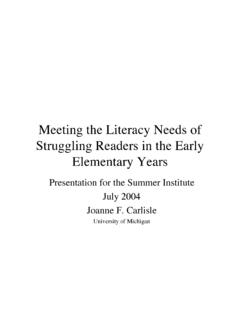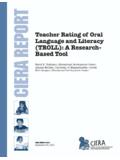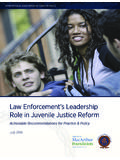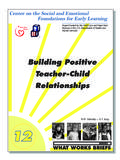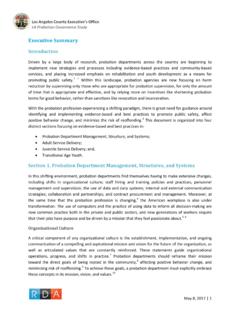Transcription of What is Developmentally Appropriate Practice in …
1 what is DevelopmentallyAppropriate Practice in EarlyLiteracyResearch-based principles andpracticesWhat does the term developmentallyappropriate mean?nNot laissez-faire nNot reading readiness nNot academicDevelopmentally appropriatenKnowledgeable teachers who are aware ofthe developmental continuum of readingnKnowledgeable teachers who can definebenchmark skills for children at differentages and grade levelsExamples:nChildren should finger-point read by theend of age 4nChildren should identify concepts of print;that print tells the story, and not the pictureby age 4nChildren should identify beginning andending phonemes using deletion tasks atage 4 Examples:nChildren should identify letters of theirname by age 4nChildren should demonstratecomprehension of a story by age 4 Examples:nMy child started to read all by himself, andhe s only 3.
2 Should I discourage this?nMy child doesn t sit still to listen to a story?Should I wait until he is older? what is early literacy?nShould it be called emergent literacy?nShould it be called beginning reading?nShould it be called reading readiness?Knowledgeable teachersnCan assess children s learning in efficientand Appropriate waysEarly literacynLiteracy begins at birthnReading and writing develop concurrentlyand interrelating; writing often comesbefore readingnChildren s understandings of the functionsof reading are clearly tied with motivation,and interest to want to learn to readnChildren learn through active engagementSkillful readingnThe fallacy of grade levelnThe artificially of reading scoresnThe ability to successfully read for literarymeaning, for information, for specificpurposesExamples:nThe National Assessment of EducationalProgress (The Reading Report Card)n There is a saying, Don t get mad, get even.
3 How does this apply to the story?Examples:nWhen turtle remains quiet about hismistreatment by Spider, the author wantsyou to:nA. Believe Turtle is afraidnB. Have sympathy for TurtlenC. Feel dislike for TurtlenD. Think Turtle deserved no dinnerThree Cue Systems in ReadingGrapho/phonemicSyntacticSemanticC ue SystemsExample:nGormanic was a brilliant groph who splinkin a clopnWhy could you read this?nGrapho/phonemic cuesnSyntacticnSemantic (?) what are the skills in the early years thatwill build skillful reading?nOral language comprehensionnVocabulary and background knowledgenPhonological awarenessnLetter name knowledgeAlso consider.
4 Access timeSkill development in the contextof early childhood settingsnChildren s learning benefits throughintegrated instructionnLearning requires children s minds (notjust their bodies) to be activenHigh levels of teacher interaction optimizechildren s learningOral language comprehensionand vocabulary developmentnDemonstrations and interactions withhighly literate adultsnExposure to high-quality books--narrativeand expositorynRepeated readings of favorite booksnBook-related conversations that focus onopen-ended responses in small groupsettingsnVisits to the libraryPhonological awarenessnPlaying with words and soundsnRhyming.
5 Singing activities that introducechildren to the sounds of wordsnActivities that focus children s attention oninitial and ending sounds in wordsn Driting and invented spellingsLetter name knowledgenFunctional print throughout theenvironmentnABC s in children s eye viewnABC songnPuzzles, games, books that encouragechildren to distinguish between lettersnLearning the letters of one s namePractices that promote earlyliteracy developmentnInteractive storybook readingnK-W-LnRepeated ReadingnWriting ( Driting, Invented spelling,morning message)nLiteracy-related playnAssessment tailored to improvinginstructionInteractive storybook readingnConsiderationsnGenrenPurposes for reading (vocabulary development?)
6 Content knowledge?)nGroup sizenQuestioning: what is it designed for--get cha or areyou paying attention? Or thinking?nOpen-ended responses: what are these for?nHow to extend learning: gingerbread man--gingerbread cookies, and how does it connect tochildren s real life?nShow example--Repeated ReadingnConsiderationsnPurpose for the activitynFrequency of repeated readingnExpected outcomes of activityWhat counts in qualityinstructionnIntentionalitynTime and pacing of instructionnCoherence of instruction in multiplesettingsnContinuing AssessmentnOngoing professional development torefine and enhance our teaching practicesFeatures of quality instructionnPlay supports children s learningnDeveloping competence enhancesmotivation and self-esteemWhat is Quality Early LiteracyInstruction?
7 NA literacy-enriched environmentQuality Early Literacy InstructionQuality environmentQuality Early Literacy InstructionnAn intellectually engaging curriculumIntellectually engagingcurriculumFigure 1. Long-range planning for Thematic Study onThe Physical WorldUnitMajor ConceptsMaterials NeedPrekindergartenGuidelinesMagnetismMa gnetic forceattracts things madeof iron and steelMagnets have manyuses and help us domany thingsObjects to test andsortBooksMagnetsThe child: uses one moresense to observephenomena analyzespatterns andrelationshipsColorsThere are manydifferent colors andthey have differentnamesPrimary colors arered, yellow and blueBooksPaintColored paperColor swatchesFood colorsThe child.
8 Uses differentcolors to createmeaning uses newvocabulary ineverydaycommunicationSoundWe can identifythings by theirsoundsSound is created byvibrations of objectsSounds can behigh/low, loud/softMusical instrumentsRecordsKitchen foodcontainersChutes and marblesPopcorn cookingThe child: Identifiessimilarites anddifferences Begins todistinguishamong soundsof severalinstrumentsQuality instructionnClear, systematic, and scaffoldedinstructionScaffolded InstructionDemonstrationQuality instructionnWell-tempo ed minds-on instructionnLanguage richnSecure attachmentsnIntegration of writing and readingSelf-regulationSelf-regulationFun ctional readingQuality literacy instructionnParent and community involvementParent involvementParent involvement

